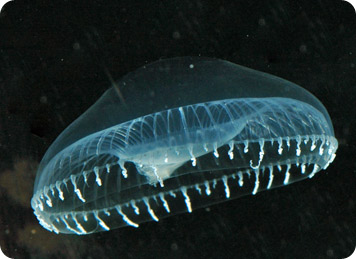A jellyfish that’s found in the Pacific Northwest seems simple enough. Known as Aequorea victoria, it’s only a few inches across, and it doesn’t sting, so you can float right through it without harm.
 A glowing jellyfish. Credit: http://en.wikipedia.org/wiki/File:Aequorea4.jpg
A glowing jellyfish. Credit: http://en.wikipedia.org/wiki/File:Aequorea4.jpgYet a substance that’s produced by the jellyfish has become one of the most remarkable tools in modern medicine and biology -- a tool that earned three scientists last year’s Nobel Prize for chemistry.
The substance is known as GFP -- green fluorescent protein. It produces a faint ring of green light around the rim of the jellyfish’s “umbrella.”
A Japanese researcher was the first to study GFP, in the 1960s. Later, other scientists realized that they could insert it into many types of cells to make their proteins glow, too. That’s useful because proteins are too tiny to see, even with powerful microscopes. Yet they control many of the body’s functions, so they’re extremely important. Inserting a glowing tracer molecule makes them easy to study.
Scientists cloned GFP in the 1990s, so they don’t have to get it from the jellyfish any more.
And they’ve come up with an amazing range of uses for it -- tracking cancer cells, for example, or studying the loss of brain cells in Alzheimer’s patients, or even finding toxic substances in drinking water. And multi-colored forms of GFP created in the lab have allowed scientists to map the brain paths of laboratory animals.
So the soft glow of a simple jellyfish is helping researchers push the frontiers of medical science.

